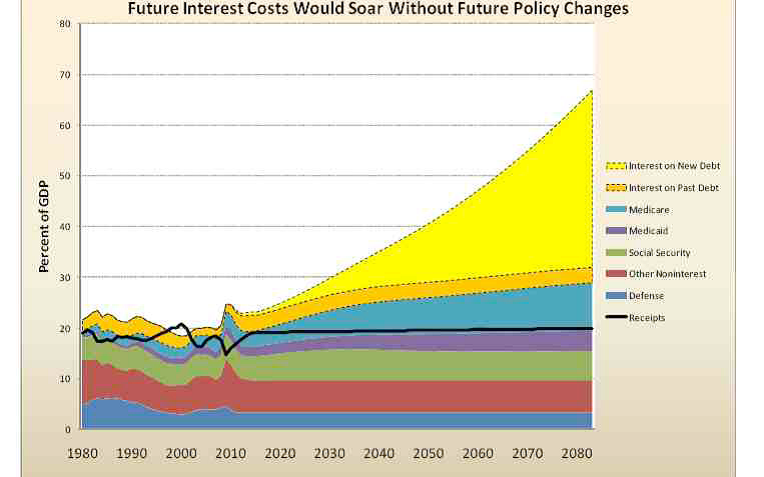We have all faced situations where everything is about politics. Unfortunately, it seems that we have not learned yet that while everything is politics, politics is not everything. The EU this week tried to “solve” the impending crisis. All that it accomplished was to buy a few months time. In the US the negotiations about the fiscal cliff seem to address symptoms rather than the fundamental causes. In life we succeed or fail in general – and in asset allocation in particular – by the judgment calls we make. When we think right, we act right. When we think wrong, we act wrong and pay the price sooner or later. Making judgment calls – while avoiding the herd mentality, neglecting the music on Titanic, as well as the marketing calls that lack substance – assumes that the assumptions we make are solid. My fear is that both in the US as well as in the EU the discussion regarding the fiscal cliff and the EU debt crisis is taking place based on the wrong principles and assumptions. The outcome may not be as good as the public relations campaigns (including those with vested interest) want to portray.
Because of that, we believe that volatility will continue on both sides of the Atlantic, an intentional choice to go over the fiscal cliff (higher taxes, significant cuts in spending) in the US may be made, asset classes may exhibit significant turmoil, while prudent investors will be able in that time period to invest in solid assets that have long term value.
Let us start with the US situation, and review the following graph which we first published in our newsletter in April 2010.
The Financial Report of the United States in its 2009 publication warned that absent policy changes 92% of federal taxes will be needed to pay non-discretionary expenses such as interest on the debt, and entitlements, by 2019! Therefore, unless we address those two main issues, all we are accomplishing through the high-level negotiations is to buy time (recall that politics is everything) while undermining the long term productivity of the nation, and thus the so needed wealth creation mechanism.
A crisis may erupt as long as entitlements and the tax code remain unreformed, and big banks are not broken into pieces. Speaking of the latter, the following table tells us how inefficient and thus unproductive big banks are.
Certainly, we can create a banking sector that can have a much better risk-adjusted returns to its investors, as long as we break up the perpetrators that created the financial crisis.
Let’s now address the newest EU plan. Here are its main points:
• Lower interest rates for Greece on existing loans. We have been arguing for a moratorium on interest rate for more than 18 months now and we dedicated our December 2011 on that topic.
• Roll over Greek debt and extend maturities dates on bonds.
• Return profits made on Greek bonds (when they were bought at about 17 cents on the Euro and now may worth a bit over 34 cents).
• Lend money to Greece to buy existing bonds in the market (up to around € 10 billion).
According to this and with some creative accounting, the Greek debt will drop from around 180% in 2013 to approximately 124% in 2020. Here are some of our reservations:
• This plan assumes too much and its unrealistic assumptions are unlikely to materialize (we have seen this troika movie three times thus far since 2009).
• It assumes that Greek banks will lend the money they will get from their recapitalization. With all due respect we believe that this will not happen, since the banks have already spent the money when forced to buy Greek Treasuries in order to keep the government funded in the last year.
• This plan assumes that the EU-wide crisis is a liquidity crisis. All along we have been arguing that this is an insolvency crisis and unless the debt is written off (or at least a good chunk of it), there are no valid growth prospects that could create jobs and incomes (see 2011 commentaries on the concept of seisacthia).
• The plan assumes that the bond buying program will materialize by December 12 of this year. What will happen if it does not?
• The numbers simply do not add up, and even at 120% ten years from now, the debt is unsustainable.
• When the crisis started, Greek debt stood at 120% of GDP. Thus, after extreme austerity, boneheaded policies, and over $400 billion in new total financing, the accomplishment in 2022 will be that the debt will stand where it started thirteen years earlier. If that is not masochism and schizophrenia, then I do not need to know what constitutes that.
• Given the unrealistic assumptions that the plan is making, there are no provisions for funding gaps (which for certain will appear within 6-12 months).
• Additional austerity measures will be required given the unrealistic assumptions of the plan. The issue is that the Greek population cannot have any more measures. By the way it is pretty doubtful that the already voted measures can be implemented.
• The Greek economy and those of the southern periphery need to obtain again their competitiveness in order to grow, and unless they dollarize that goal may be very difficult to be accomplished. Let’s hope that those economies are only condemned to succeed.
We hold the position that no matter the political manipulations the dysfunctional workings of the Euro zone will force capital flight to the US, which if it adopts proper reforms and given its huge energy reserves, may see its prospects taking off in the next two-three years.
In the meantime, hedging is beautiful and hard assets are even better!


